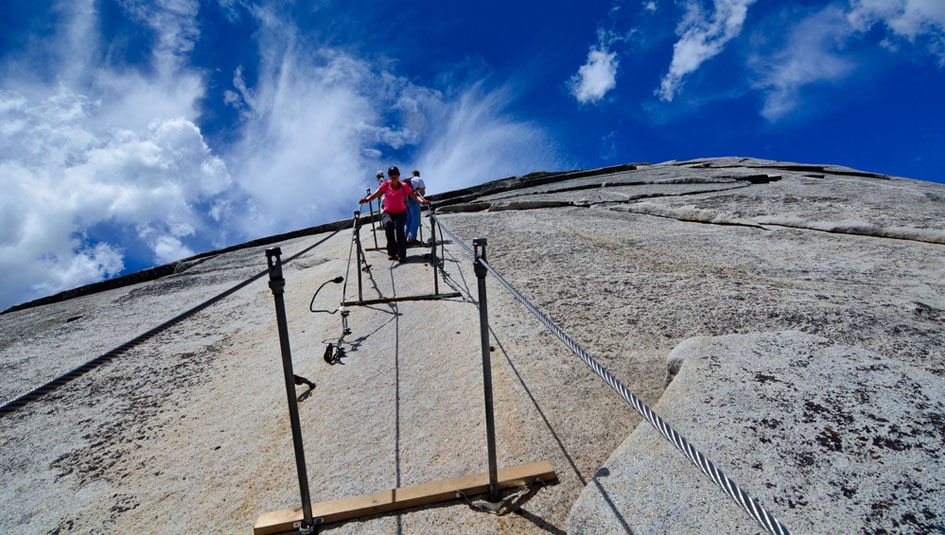Ascending Yosemite’s Half Dome While Balancing My Glucose Levels

I was diagnosed with Type 1 diabetes at the age of five, and I’ve had few complications in the 51 years after my diagnosis. I’ve enjoyed an active life as a mom, a business executive, a volunteer, and an avid hiker. In Spring of 2016, I’d been invited to hike the infamous Half Dome Cables of Yosemite, a 16-mile high-elevation hike that involves a series of cable climbs to reach the summit.
To prepare, I trained with my hiking friends, learning how to handle my glucose levels in the high altitude and on longer hikes. As we trained, I watched my glucose levels constantly on my Dexcom CGM and adjusted my basal and bolus dosages with my Omnipod insulin pump when I was encountering challenging terrain on the training hikes. When hiking, I always made sure to have a stash of candy, granola bars, Honey Stingers, or apple sauce packets in my pockets.
Read “T1D and Scaling Mt. Kilimanjaro.”
On the day of the Half Dome climb, we left camp before dawn. I didn’t bolus for my breakfast as I knew we would start to climb fast and that would burn off some carbs. My glucose levels were good for about an hour and a half, but then I realized I’d forgotten to reduce the basal dose. My levels started to drop and my CGM beeped. The whole hiking party was alerted, of course. I reassured my hiking buddies that everything was okay, and I broke into one of my many trail snacks. I recovered and reached the first stop at Vernal Falls, where we enjoyed the sunrise and refueled ourselves.
We then proceeded up to the next landmark, Nevada Falls, and I had no significant glucose fluctuations. The next stop was through Lower Yosemite Valley to the foot of the infamous Half Dome trek.
Read “In the Himalayas with Undiagnosed Type 1 Diabetes.”
I suppose I still had a lot of carbs in my system and not enough insulin on board to process them. By the time we climbed to the subdome of Half Dome, my glucose levels were approaching 200 mg/dL. I had my insulin pump calculate a bolus, then reduced it a little to compensate for the next part of the hike – the cables.
At this final ascent, I had to hang on and climb straight up. I decided to raise my basal rate a smidge. By the time I had pulled myself up the extremely steep cables, my levels were down to 156 mg/dL and it was all good. I was extremely happy to be on the summit of Half Dome, a spot once thought inaccessible to humans.
The trick of a mountain hike like this is that you have to get down, too. As we started down the mountain trail, I gave myself a small bolus and I brought my basal rate back to normal. My pump started alerting me that I’d need to change my pod soon, as I had only about 10 units left in it. I told my hiking friends that I was good and it shouldn’t need changing before we got back to camp.
I was wrong. Soon after, the pump gave me what I like to call the “scream of death” warning, which is hard to ignore. Standing on the trail, I let everyone know I needed to replace my pod. They took a water break as I attached the new pod, and we were on our way again in five minutes. I deactivated the old pod, but didn’t remove it until we got back to camp.
We made it back to camp without further incident. It was all good after what eventually clocked out to 19 miles and 10 hours of hiking and climbing. Laughing and drained, we headed out for a much-needed beer.
My next adventure is hiking a section of the Camino de Santiago in Spain, a long trail that has been traversed by thousands of Christian pilgrims, and others, over the centuries. I will be hiking 150 of the 500 miles, and it will be my biggest challenge yet because I will have to carry all my supplies in a small pack.
See you on the trails! Happy hiking.
Lead Image: Onnes / Shutterstock.com
Thanks for reading this Insulin Nation article. Want more Type 1 news? Subscribe here.
Have Type 2 diabetes or know someone who does? Try Type 2 Nation, our sister publication.
